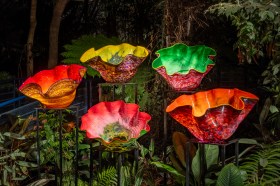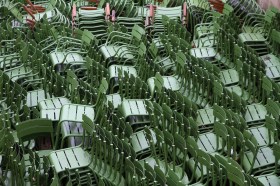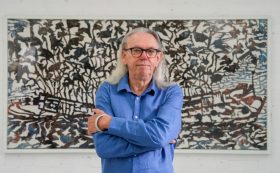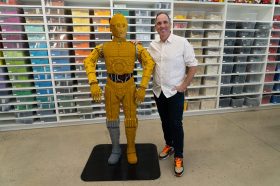Photographer John Gollings is delivering the Open House Melbourne’s Heritage Address today, Monday 29 July. It recognises the impact he has had on documenting the built environment – something for which he was made a Member of the Order of Australia (AM) in 2016.
While Gollings is perhaps best known for photographing Australia’s iconic buildings – in particular in Melbourne and Surfers Paradise – he also happens to have photographed some of the most famed, from the Queen to Mick Jagger and Bob Dylan.
ArtsHub catchers up with Gollings to find out how it all started, and why he is so attracted to photographing buildings.
Jump to:
In Gollings’ words
How would you describe what you do to a non-arts friend?
Simply, ‘I travel the world at my own expense photographing dead cities.’
What qualifications do you need for this job?
Gollings says: ‘To be an adventurous photographer who can work quickly under difficult circumstances, and make excellent images.’
Born in 1944, Gollings describes himself as self-taught, adding in his bio that, ‘at nine years old I was a photographer.’
He does, however, acknowledge that, ‘along the way I was mentored by a clutch of remarkable photographers – Ezra Stoller, Ansel Adams, Wolfgang Sievers, Mark Strizic, David Moore and Max Dupain.’
How did you get your start in this career?
‘I say “yes” to every offer, and I was offered a chance to go to New Guinea [in 1970] to document village life, and [since then] other opportunities followed my reputation for pulling off tricky jobs,’ Gollings tells ArtsHub.
He continues in his online essay: ‘By 23 I had finished studying architecture at Melbourne University and was offered a photography assistant’s job at Orpin and Bourne, a small and very creative boutique advertising agency. Kevin Orpin, an energetic autodidact, taught me design and marketing, while Bob Bourne, freshly returned from London’s swinging 60s, taught me lighting.’
Read: So you want my arts job: 2D Type Artist
His big break came when he was assistant to photographer Peter Gough. Gollings explains: ‘He tired of me after three months, but the studio decided to launch me as a photographer in my own right. My folio was eclectic, but I was offered a job reshooting a Marlboro cigarette campaign when a week’s shoot by a famous photographer didn’t satisfy the art director. For $250 for a day’s work my career was launched and the agency landed three huge billboards.’
‘I was an untrained nerd who loved the technology, but had sleepless nights before each shoot, petrified of not knowing what to do.’
Gollings adds that, meanwhile, his former architecture classmates had begun to design and construct significant projects. ‘I was their go-to photographer’, explains Gollings. ‘I was really starting to shoot some pretty major architectural work in the late seventies. By the mid‑eighties, I had firmly committed to just photographing buildings.’
His first successful architectural shot was Frank Lloyd Wright’s Sturges House in 1976.
How collaborative is this job?
Not much. I’m generally alone, but I often need permission so I have to be nice to authorities.
What’s an average week like?
Dawn to dusk in a foreign country, with no language and strange food, hoping for interesting weather, day after day. I work 24/7, so a week is seven days.
What’s the most common misconception about your job?
That is easy, well paid and exotic.
How competitive is this job?
Commercial photography, my day job, is very competitive and low prices are the only criterion often.
In an interview for your job, what skills or qualities would you be looking for?
The initiative to set your own brief, and execute it with style and panache.
What’s changing in your professional area today?
The move to video and artificial intelligence.
What’s the weirdest thing that’s happened to you in this job?
Having two engine failures on helicopter jobs.
What about gender balance and diversity in your industry?
Everyone is self-employed, so gender and diversity come with the territory. Skill, and a pleasant personality, are all that counts.
The move from fashion to dead cities
Gollings has travelled to work by donkey, tuk-tuk and helicopter.
He explains: ‘I stumbled through the 60s, 70s and 80s shooting fashion and advertising, including ‘Get Wrecked on Great Keppel’ (1984), Dunk Island, Sportsgirl, Levante Hosiery, Bri-Nylon, Sitmar Cruises, Jag, Prue Acton, Air Lanka, Air Nauru, Oberoi Hotels, Hyatt hotels and many more.
‘Many of the travel accounts took me to exotic locations that, in turn, gave me the opportunity to further my personal photographic projects… With the growing realisation that an old fashion photo has no immediate value, I started to concentrate on architecture photography exclusively from the 80s on.
‘I had discovered dead cities and started my own projects in New Guinea (1970-73), India (1980-83), Cambodia (1990), Western China, Indonesia, Turkey and Libya. This urban documentation has become an obsession.
‘In some ways I’m better known in India, where whole museums have been built to house my work on the Vijayanagara Empire.
Read: ‘In his own words’, by Gollings.
From the past to the future
Apart from exotic places abroad, Gollings has also documented places such as Melbourne and Surfers Paradise, and the rock art in the Kimberley.
In 2010, Gollings was co-Creative Director with Ivan Rijavec of the Australian Pavilion for the Venice Architecture Biennale. His website explains: ‘The exhibition compared the existing state of Australian cities with their counterpoint in the mining holes of the west, to the possibility of a radical, new, paradigm city of the future. This was all photographed from a helicopter in 3D or rendered in 3D using CGI techniques by Flood Slicer, part of the Gollings collaborative studio, along with Design By Pidgeon, who designed the graphics.’
One of his most recent projects focuses on capturing Nawarla Gabarnmang, an Indigenous rock shelter located in Arnhem Land – the oldest human construction photographed by Gollings.
You can see Gollings’ photographs of the Narwarla Gabarnmang Rock Art Shelter – and his portrait of Auntie Margaret, the custodian of the rock shelter – on permanent display in the National Portrait Gallery, Canberra.
To view John Gollings’s other projects, spend some time browsing his website.





